Here is your first Dairy Goat 101 tip: Learn how to milk a goat before you bring two goats home with full udders. Tip number two: Don’t try to milk two goats on the tailgate of a truck in the dark while you daughter Googles ‘how to milk a goat’. And, yes, I have more awesome tips for you!
 Dairy Goat 101 tip number three: Don’t start building a milking stand at 8AM for their 9AM milking—it will NOT look awesome. But, as my ever patient and loving husband pointed out—building a ‘test’ milking station is a great way to figure out what sucks about it and what requires improvement. This was his nice way of pointing out how god-awful-ugly it was, and suggesting it needs improvements in the kindest possible way. I’m going to keep him, sorry ladies.
Dairy Goat 101 tip number three: Don’t start building a milking stand at 8AM for their 9AM milking—it will NOT look awesome. But, as my ever patient and loving husband pointed out—building a ‘test’ milking station is a great way to figure out what sucks about it and what requires improvement. This was his nice way of pointing out how god-awful-ugly it was, and suggesting it needs improvements in the kindest possible way. I’m going to keep him, sorry ladies.
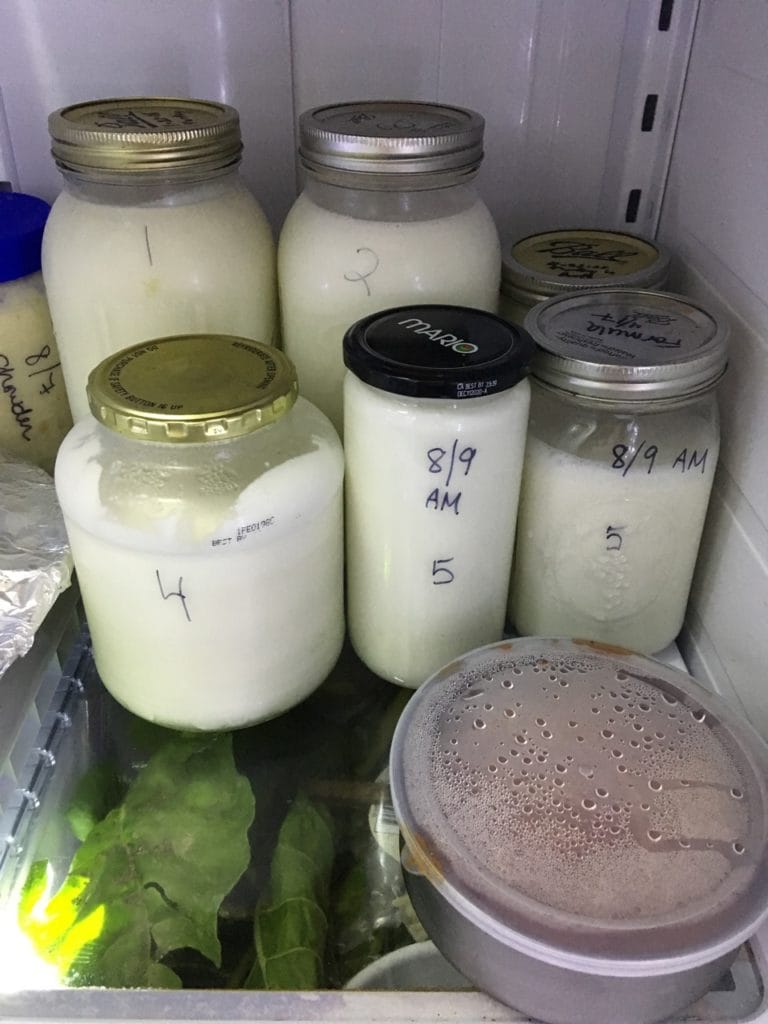 Another Dairy Goat 101 tidbit, figure out what to do with a crapload of milk. The first few days with our new, one-year-old Nubian does, Apple and Candy, only produced about one third of a gallon daily. We purchased them just after their first freshening (when they begin to produce milk) once their kids were weaned. They had been mostly grazing at their former home and the milk had a slight bitter, almost earthy taste.
Another Dairy Goat 101 tidbit, figure out what to do with a crapload of milk. The first few days with our new, one-year-old Nubian does, Apple and Candy, only produced about one third of a gallon daily. We purchased them just after their first freshening (when they begin to produce milk) once their kids were weaned. They had been mostly grazing at their former home and the milk had a slight bitter, almost earthy taste.
By the end of the first week the ladies had edged up to half of a gallon daily from each goat. Soon our fridge was swamped with jars of creamy white deliciousness. With each day on grain and hay, in addition to the decreased grazing their milk turned a milder flavor more indicative of cow’s milk. Dairy goats can produce about a gallon a day in peak production.
Dairy Goat 101 Milk Production Tips:
To produce lots of milk, dairy goats must be happy, well fed and healthy. These are the things I found out while looking up the best practices for my new herd. I’m not yet practicing all of them, and as I learn more there will be updates.
- Breeding at optimal age, weight and health
- Weaning and separating kids
- Proper diet for calories to produce milk
- Take into consideration climate, weather and temperature
- Clean housing
- Kind and patient caretakers
- Consistent good health
- Aspects of preventative care
- Low stress environment
- No stinky bucks nearby
- Milking regularly
- Completely emptying the udder
After getting our two new milking does home, we had fed them grain and hay each day before letting them out to graze. Once they were out I’d teach them boundary lines by walking them near the borders of our property then calling for them to return. They had been kept in a very large, open pasture with fencing. They only grazed for short periods to both fatten them up on the higher calorie grain feed, and to bump up the milk production. They also love grain which made us their favorite new people on Earth—a major perk for stubborn and large (relative to my 100-pound string-bean-like frame) animal.
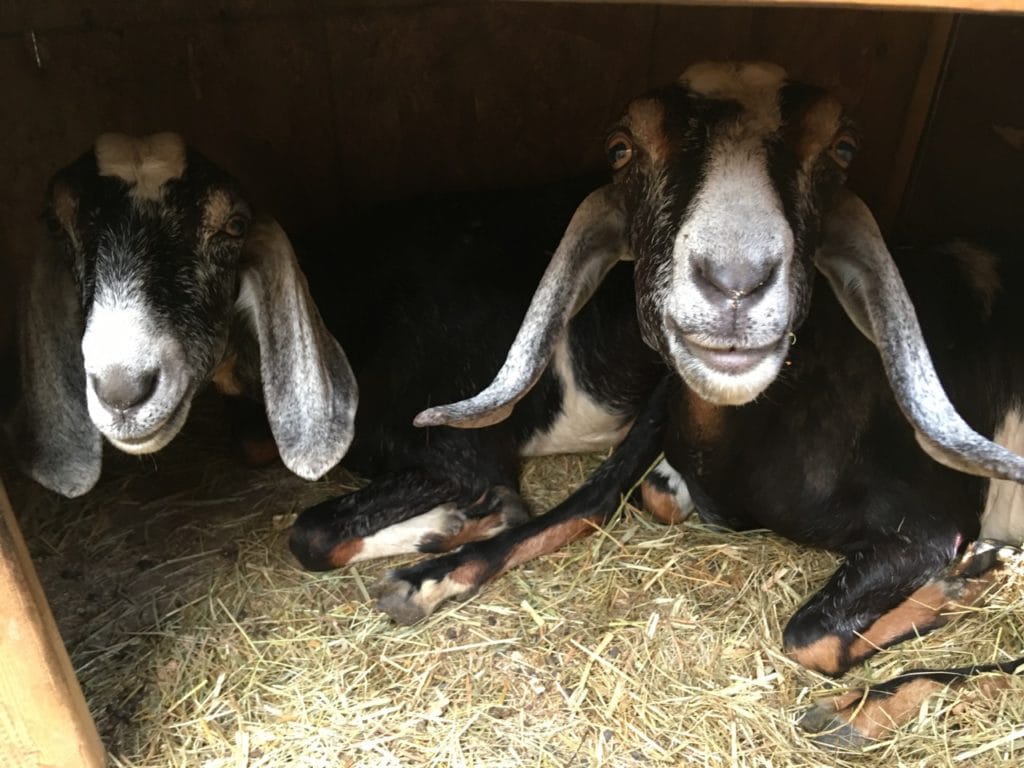
One of them had looked a bit thin and had loose stool—not the coffee bean poops one would expect to sprinkle out as she pranced curiously through her new surroundings. Within a few days both ladies were coming when called and had adjusted to their new diet wonderfully. We’d also picked up a little buckling with the milkers. The trio had black coats with white markings. They followed me around and enjoyed long walks while I picked berries and did the usual morning, noon and evening rounds. Though when we were out they tended to stick to themselves rather than with the two brown goats, Easy and Fireball, we’ve had all summer since early spring. By the end of their first week on our homestead, both leapt on the milking stand when prompted.
So why did I learn to not do these things instead of being prepared? I’m all about the deals and networking locally. They fell into place and we worked around it. I had the room and bedding all set. A yearling Nubian who just freshened with registration papers could be well over $600—let alone two. When I found some only an hour away that we could afford and would give us milk through the winter my heart fluttered with goat joy.
Oh, another Dairy Goat 101 beginner’s tip: Don’t pull or push a goat, lead them with food or call sweetly. They are stubborn creatures, but are social and happy to please when food is involved. But, in the end they will do what they want. At milking time they might decide it’s time for a stroll, or like this lady below—ignore the stand and cut to the food by any means possible.
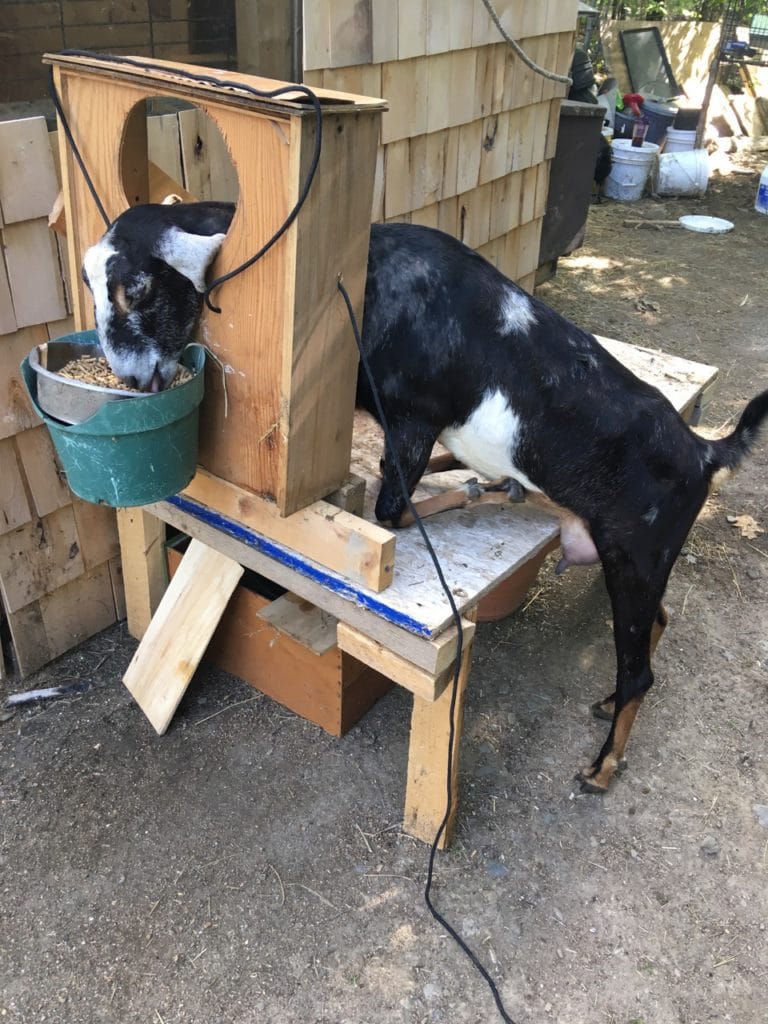 Ready for another Dairy Goat 101 hot tip? They eat and poop and pee a LOT. Their stall will require lots and lots of bedding. Know where to source your bedding ahead of time by finding a low cost, local and reliable source. I’m very lucky to have inherited a barn full of sawdust and chopped hay that’s about a decade old. Look nearby for sawmills, woodworking shops, and log yards—trust me, somebody knows of somebody who wants you to clean out their waste product sawdust. You’ll just have to ask around. Older folks don’t use social media, but they do read local classified ads. Broadcast your interest in bedding and lock in a weekly pick-up or delivery before your goats arrive.
Ready for another Dairy Goat 101 hot tip? They eat and poop and pee a LOT. Their stall will require lots and lots of bedding. Know where to source your bedding ahead of time by finding a low cost, local and reliable source. I’m very lucky to have inherited a barn full of sawdust and chopped hay that’s about a decade old. Look nearby for sawmills, woodworking shops, and log yards—trust me, somebody knows of somebody who wants you to clean out their waste product sawdust. You’ll just have to ask around. Older folks don’t use social media, but they do read local classified ads. Broadcast your interest in bedding and lock in a weekly pick-up or delivery before your goats arrive.
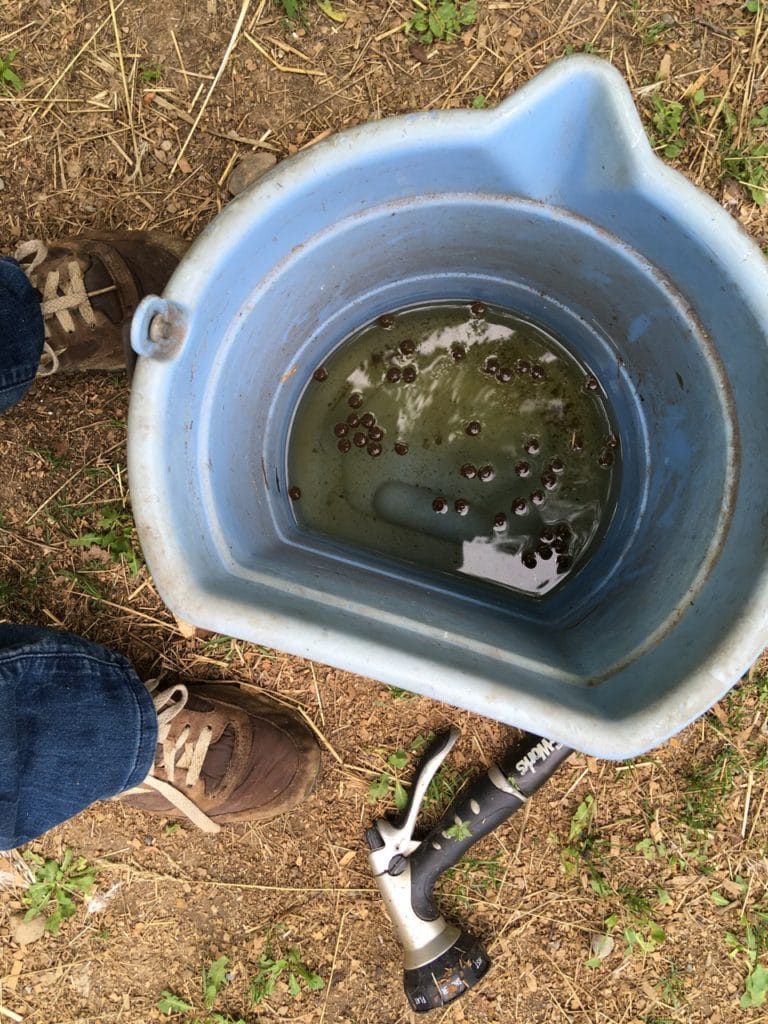
Dairy Goat 101 mess prevention tip: They will kick over their water if it’s not hitched to the wall—and for extra fun, they will get it hooked around their long neck and freak out. Hook it securely without causing a tripping or entanglement hazard. Once the water is on the floor they will trudge through and mix it with bedding a poo. You’ll have messy goats to contend with come milking time. This does not need to be elaborate. I use a 5-gallon bucket that hooks to the wall in a corner to keep their head out of the handle. And, no, those are NOT Cocoa Puffs guys. You’ll need to clean the water out twice a day.
Out of all livestock animals, goats are the worst wasters of hay and will need a special hay manger to keep it from getting strewn all over the stalls. You could buy a fancy-pants expensive one, or you could make it in a morning with pallets and scrap lumber. Two of the first investments I made for feeding equipment was a secure feed bin and a sturdy corner troth to dump grain in.
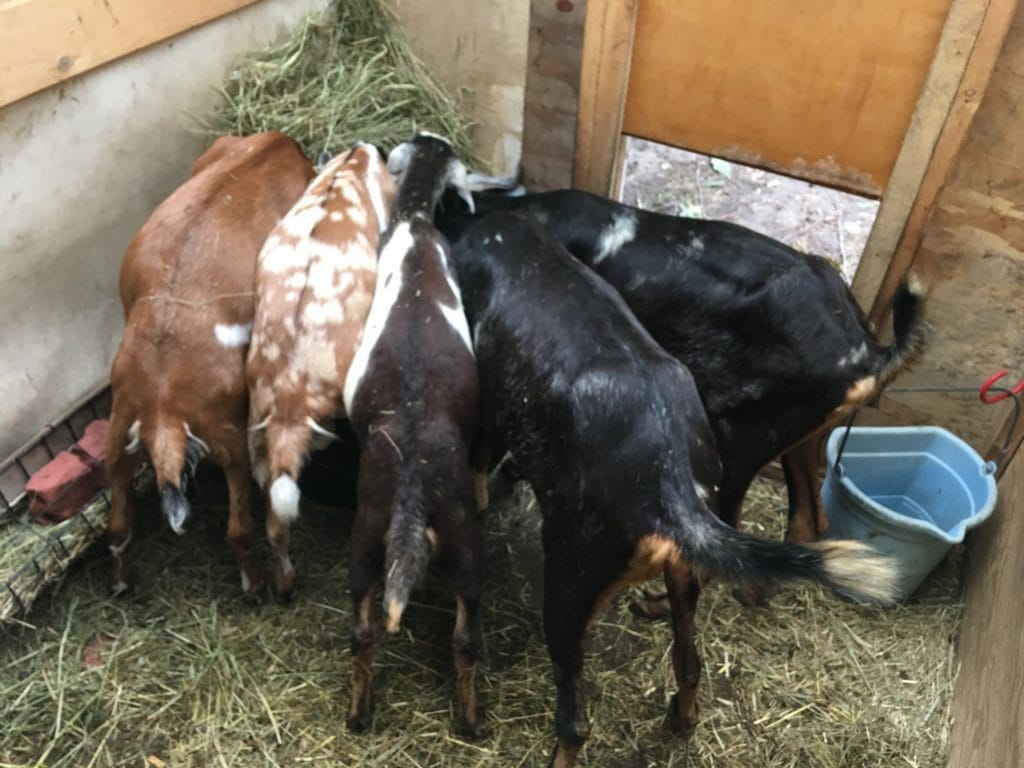 The biggest, proudest, most self-important goat gets the most grain. To insure they all get their allotted amount, I have to separate mine by using a sliding door to trap the boss goat outside while the others eat. I just shake the grain scoop and she comes hauling ass through that door and I lower it down with the rope. While the others eat I’ll scratch her head to keep her at bay. I’ve seen them pushing each other around and vying for the ‘herd boss’ position. Apple head butts Easy, our rapidly growing spring doeling, at feeding time and to get the best napping spot under the goat shelf.
The biggest, proudest, most self-important goat gets the most grain. To insure they all get their allotted amount, I have to separate mine by using a sliding door to trap the boss goat outside while the others eat. I just shake the grain scoop and she comes hauling ass through that door and I lower it down with the rope. While the others eat I’ll scratch her head to keep her at bay. I’ve seen them pushing each other around and vying for the ‘herd boss’ position. Apple head butts Easy, our rapidly growing spring doeling, at feeding time and to get the best napping spot under the goat shelf.
Another Dairy Goat 101 chunk of advice: don’t EVER leave a goat all alone for more than a few minutes. You’ll NEVER hear the end of it. The bleating screams will be seared into your ora. These are herd animals. They need each other. Goats become tightly bonded with their keepers and their herd. If you are the ones to raise them rather than the dam, they will think you are goat mama and call for you each time the hear, see or miss you. They want to be with you at all times. By call, I mean they scream as loud as they can. Sure it’s cute the first 6,012 times, but by 6,013 it’s slightly irritating.
Our last, but possibly most important Dairy Goat 101 tip today: if you buy bottle babies to bottle feed at your home it’s all fun and games at first. They’re so cute. They are so funny. But after two months of feeding them a few times a day the whole thing can get old. I’ve breastfed three children—this bottle thing is ridiculous. Goat formula is pricy! $60 for a bag that will last a week!? I. Can’t. Even.
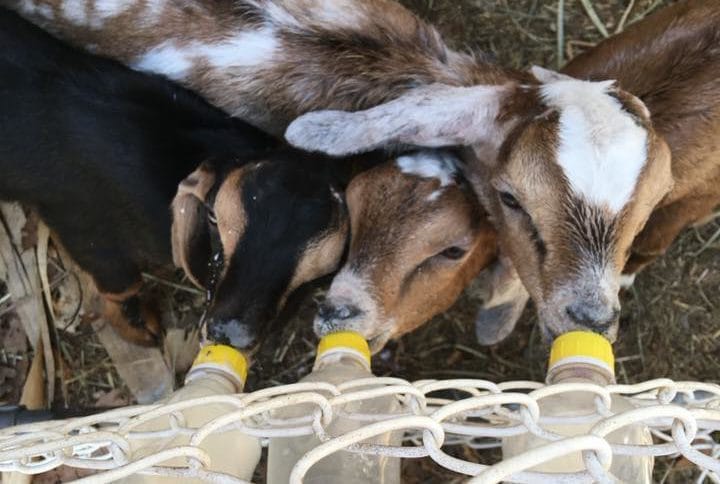
So why do I have goats? I freakin’ love them. Don’t tell my husband—but I secretly ADORE the screaming bleats. The nasty often poop encrusted hoof prints on my shirt are my badges of honor. The little throaty locator mah-has when they lose sight of you and you’re only four feet away are the sweetest sound ever.
The milk is thick, creamy, full of good-for-you stuff and will quickly fill all our dairy needs. I used cream skinned off the top of last night’s milking in my coffee this morning. My son (thinks he) is lactose intolerant and goats milk is considered ‘lactose free’. We can make cheese, yogurt, soap, and ice cream—all things that are expensive for our family to buy, and in turn; profitable to sell to other families.
Goat’s manure adds to the high nitrate poultry manure to create a more balanced composting process. They eat leaves, grasses, goldenrod, clover, mosses—anything green. There are a few things they ought to avoid eating large amounts of in nature—but the little boogers browse and only nibble as they move allowing them a great diversity of food. And, at the end of the day, who am I fooling? I’m in love.
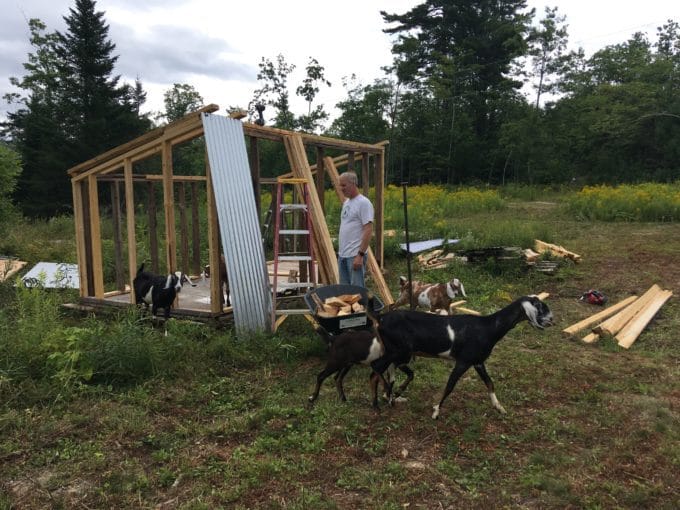
Comments are closed.